The MH370 search team is re-checking more than 40 sonar contacts to make sure they are not the shattered remains of the missing jet.
The sonar contacts are anomalies found in previous sweeps that did not fit the profile of a typical aircraft debris field but raised questions about their origin. The sonar data include some contacts that look more anomalous than others although the Australian Transport Safety Bureau, which heads the search, believes most are almost certainly geological formations.
The search in the southern Indian Ocean has been underway since the shortly after the Malaysia Airlines Boeing 777-200ER disappeared in March, 2014, with 227 passengers and 12 crew on board while travelling between Kuala Lumpur and Beijing. Two ships, the Fugro Equator and China’s Dong Hai Jiu 101, are still conducting the search in water up to 5 kms deep.
About 96 per cent of the search are has been probed using deep tow sonar but there some areas this technology cannot adequately penetrate. These areas are marked and an autonomous underwater vehicle (AUV) currently carried by the Fugro Equator investigates those over a size determined by studies of underwater debris fields from previous aircraft accidents.
The torpedo-like Hugin 4500V AUV comes-equipped with a state-of-the-art navigation system and uses the latest battery technology to allow it to operate for 30 hours, travelling at about four knots.
Highly manoeuvrable and with a turning radius of about 15m, it is equipped with sonar and video surveillance equipment. It is generally programmed to search a particular area and the data downloaded after it returns to the ship but it can also receive commands though an acoustic system.
In addition to the AUV, the searchers also have remotely operated vehicle (ROV) carried by the Dong Hai Jiu 101 and operated by US firm Phoenix International .
The squat ROV — which is tethered to the ship above by a cable, remotely piloted and comes equipped with video and still cameras — is being used to check the 40 plus sonar anomalies.
The Remora III is the same ROV was also used in the recovery of Air France flight AF 447 after it plunged into the Atlantic Ocean in 2009. That operation successfully recovered the plane’s black boxes but it took two years to locate them even though searchers knew the position of the plane when it went down.
Decent weather is needed to launch and recover both vehicles and conditions have been improving in the southern Indian Ocean after a fierce winter which delayed operations. The search is entering the December-March period providing the best weather as searchers move to complete the sweep 120,000 sq. km high priority search area by early next year.
The outstanding search area contains some of the most difficult terrain, although the AUV has covered much of it in the previous two summers. While there is still a possibility the plane may be found in the current sweep, searchers are bracing themselves for the eventuality it will not.
A meeting of transport ministers from Australia, Malaysia and China decided earlier this year that the search, which has already cost $180m, would not be extended unless compelling new evidence emerged.
Experts from around the world met in Canberra recently to review the evidence and a report on their findings is expected to be released within weeks.
The experts included several B777 captains, scientists, representatives from accident investigators in the US, the UK and Malaysia as well as the aircraft manufacturer and technology companies such as Inmarsat and Thales.
























